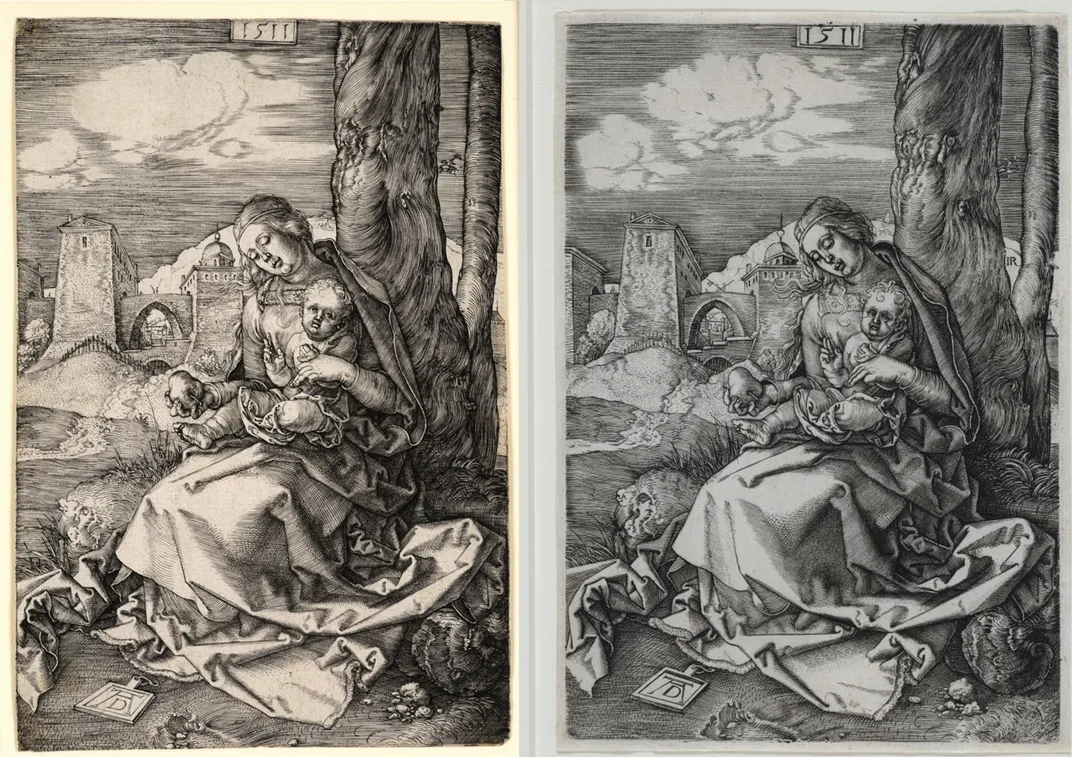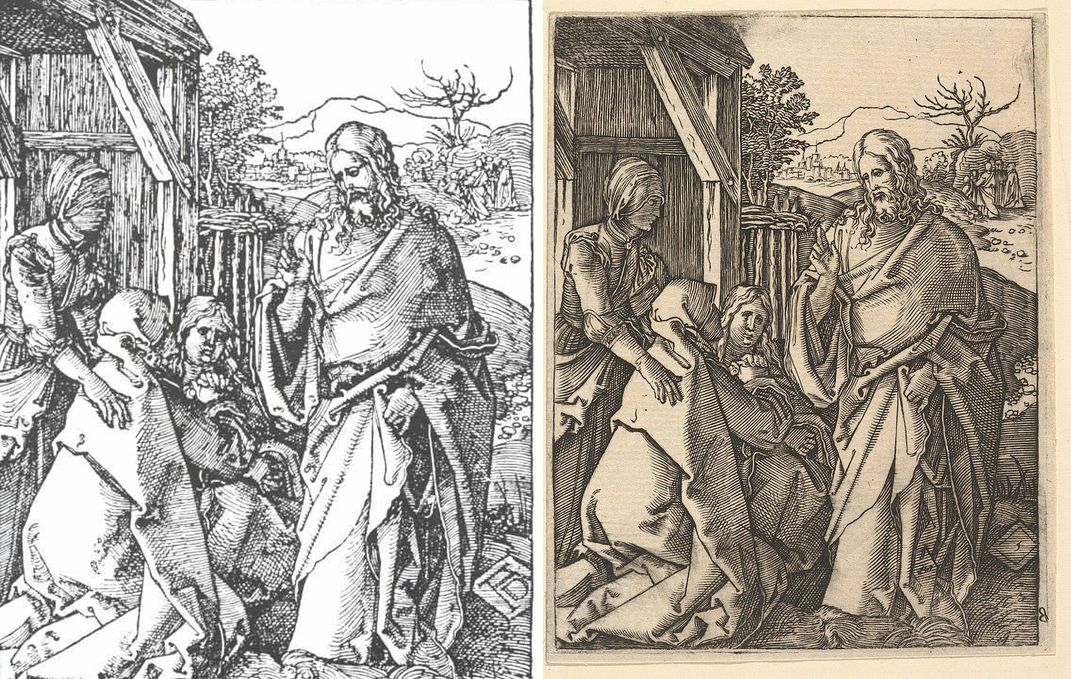What Differentiates Renaissance Copies, Fakes and Reproductions?
An Austin exhbition argues that copies, despite the negative connotations associated with the word, are not inferior to so-called “originals”
:focal(346x93:347x94)/https://tf-cmsv2-smithsonianmag-media.s3.amazonaws.com/filer/05/56/0556abae-7b62-4ded-ae03-e58c9cc39437/screen_shot_2019-02-21_at_90315_pm.png)
Throughout art history, the lines between mimicry, reproduction and forgery have often been blurred. While forgery, defined as passing one’s work off as someone else’s, is fairly easy to differentiate, the boundaries of originality are harder to tease out. Take, for example, Andy Warhol’s Pop Art Brillo Boxes—which not only copied an existing commercial design, but also exist in such quantities that it is impossible to tell which were created directly by the artist versus his team of assistants and carpenters—or Marcel Duchamp’s “L.H.O.O.Q.,” a doctored, mass-produced version of da Vinci’s “Mona Lisa” indistinguishable from the original apart from hand-drawn facial hair and a string of letters inscribed below the portrait. Looking to ancient times, BBC Culture’s Jason Farago notes, the Romans considered their contemporary replicas on par with original Greek statues—a sentiment that persists to this day, with many museums spotlighting later copies of lost classics.
For Albrecht Dürer, a master painter and printmaker active during the Northern Renaissance, originality was a more straightforward concept. As he warned in the impassioned introduction to his 1511 “Life of the Virgin” series, “Beware, you envious thieves of the work and invention of others, keep your thoughtless hands from these works of ours.” But what Dürer considered plagiarism, others, including engraver Marcantonio Raimondi, viewed as tribute, or even free publicity. Dürer ultimately took Raimondi to court in what art historian Noah Charney describes as “the first-known case of art-specific intellectual property law brought to trial." To his dissatisfaction, the Venetian panel took Raimondi's side, pointing to small changes made by the artist as proof of his benign intent.

The questions raised by this early copyright battle continue to divide scholars and art lovers today. As Lydia Pyne asks for Hyperallergic, “Where does ‘the original’ end and ‘the copy’ begin? And, more to the point, where does ‘the copy’ end and ‘the fake’ begin?”
An ongoing exhibition at the University of Texas at Austin’s Blanton Museum of Art draws on prints by Dürer, Raimondi, Raphael, Michelangelo, Giorgio Ghisi and other Renaissance giants to explore this oft-tenuous relationship between artist and copyist. Titled Copies, Fakes, and Reproductions: Printmaking in the Renaissance, the show makes the argument that copies, despite the negative connotations associated with the word, are not necessarily inferior to so-called “originals.”
Renaissance prints fall under two main categories: woodcuts and engravings. The former were made via relief printing, in which parts of a wooden block were cut and covered in ink to create an imprint. Woodcuts often involved multiple people, each tasked with various stages of production. An engraving, meanwhile, used intaglio printing, a more complex process that involved carving the image into a metal plate, filling the incised lines with ink, and using a high-pressure roller press to emboss paper into the sunken markings. Unlike a woodcut, the same individual was often responsible for the entirety of the work, leaving master engravers such as Martin Schongauer confident in claiming their authorship of a specific print. The final product also generally conveyed more detail than a woodcut could achieve.

That changed when Dürer came into the picture. The artist found a way to elevate woodcuts to the level of engravings, signing them in the same manner and cutting out the middle man to show that “each impression had the claim to originality.” This shift in the definition of authorship complicated the already muddled distinction between copies, forgeries and originals, replacing an anonymous team of artisans with a single named artist and highlighting the level of effort required to translate a drawing into either variety of print.
Comparatively, Dürer’s contemporary, Raimondi, unabashedly marketed his creations as nearly exact reproductions of others’ work. Because of this emphasis on replication over originality, none of Raimondi’s compositions can be “confidently accepted as his own,” writes Catherine Wilkinson for Art Journal. It would be plausible to mistake a Raimondi print for a Dürer print that, by nature of its creation, is inherently a copy of a drawing transferred onto a wood block or metal plate. At the same time, it would be nearly impossible to misidentify a black-and-white Raimondi print as the original, color-filled Raphael painting it mirrors.
The exhibition's final gallery features a striking example of how intent and context shape the differentiation between reproductions, copies and fakes. There, two copies of Giulio Bonasone’s “The Virgin of Sorrows”—based, in turn, on a Raimondi reproduction of an original Raphael—hang side by side, twins yet not, distinguished ever so slightly by paper and ink tones, as well as changes stemming from wear on the engraved plate used to make both prints. The prints are simultaneously copies, in that they mimic the lines and composition of an extant work, and singular artifacts in their own right, differentiated from all other works of art by the impossible-to-replicate circumstances of their creation. Dürer would likely dismiss such works as derivative at best and fakes at worst, but as the exhibition argues, the final verdict comes down to viewers' perception. Regardless of whether one subscribes to authorship's elevation over skill or vice versa, the Bonasone prints are stunning in their own right, existing as what are essentially the 16th-century equivalents of modern-day photographs.
Copies, Fakes, and Reproductions: Printmaking in the Renaissance is on view at the University of Texas at Austin's Blanton Museum of Art through June 16, 2019.
/https://tf-cmsv2-smithsonianmag-media.s3.amazonaws.com/accounts/headshot/mellon.png)
/https://tf-cmsv2-smithsonianmag-media.s3.amazonaws.com/accounts/headshot/mellon.png)